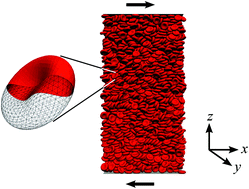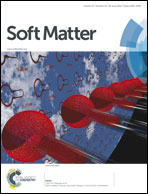Rheology of dense suspensions of elastic capsules: normal stresses, yield stress, jamming and confinement effects
Abstract
We study the shearing rheology of dense suspensions of elastic capsules, taking aggregation-free red blood cells as a physiologically relevant example. Particles are non-Brownian and interact only via hydrodynamics and short-range repulsive forces. An analysis of the different stress mechanisms in the suspension shows that the viscosity is governed by the shear elasticity of the capsules, whereas the repulsive forces are subdominant. Evidence for a dynamic yield stress above a critical volume fraction is provided and related to the elastic properties of the capsules. The shear stress is found to follow a critical jamming scenario and is rather insensitive to the tumbling-to-tank-treading transition. The particle pressure and normal stress differences display some sensitivity to the dynamical state of the cells and exhibit a characteristic scaling, following the behavior of a single particle, in the tank-treading regime. The behavior of the viscosity in the fluid phase is rationalized in terms of effective medium models. Furthermore, the role of confinement effects, which increase the overall magnitude and enhance the shear-thinning of the viscosity, is discussed.


 Please wait while we load your content...
Please wait while we load your content...